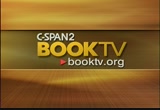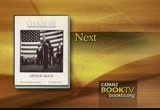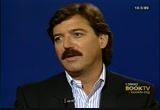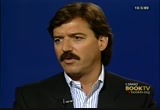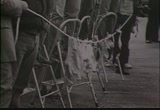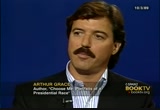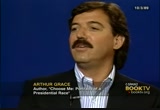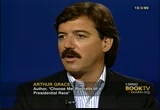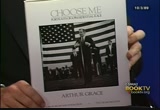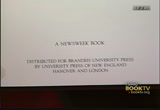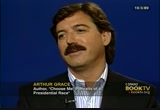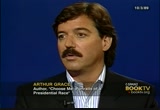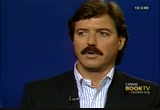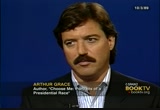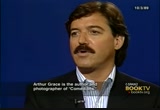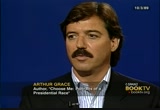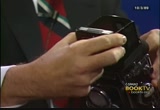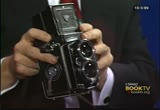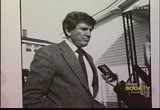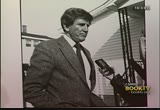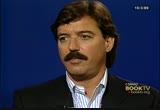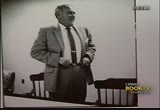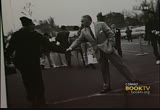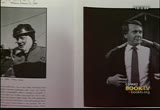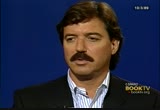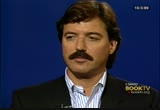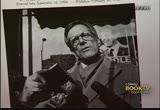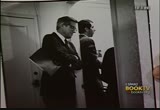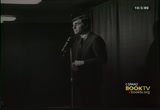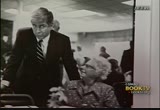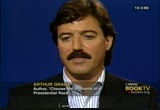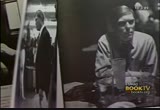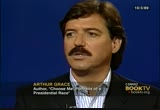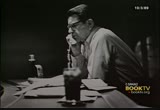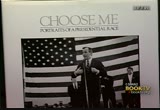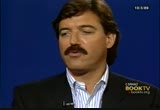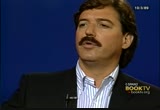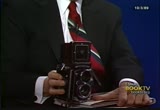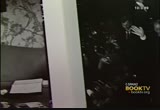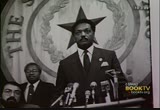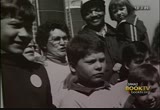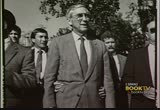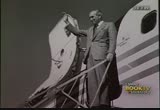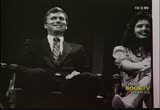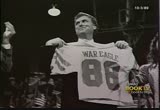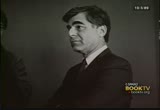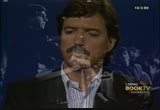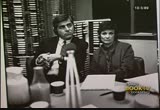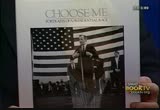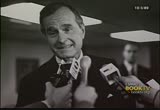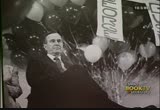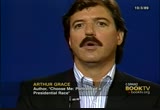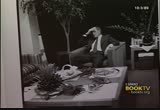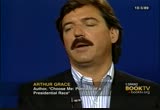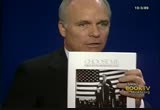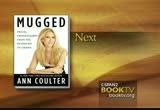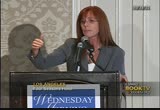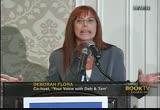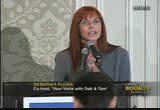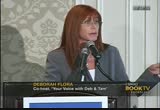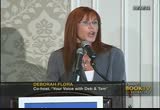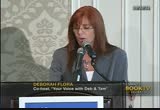tv Book TV CSPAN November 3, 2012 6:00pm-7:15pm EDT
6:00 pm
6:01 pm
among those photographed are george w. bush abdul michael dukakis and richard depp -- gephardt. and encore presentation of books now.a c-span: arthur grace you have a new book out called "choose me" portraits of a presidential198 race."7ou where did you get this idea? >> guest: well basically it was an idea that newsweek came up with in early 1987 around last january, early february. they wanted to do something different with the presidential candidates. portraits but not... they weren't sure what they wanted to do but just a different idea.y r so newsweek picture editor karen mclarkey approached me and saido do you have any ideas on this. what would you like to do? and i thought about it and i came up with this concept ofd i doing in black and white in a two and a quarter format without strobe lights, using only available or natural light. and we tried it out first witht gary hart. we went out to -- i believe it s was cleveland early on in
6:02 pm
february of 1987 and i had the first assignment out there.wa i came back and showed them the photographs and they were veryhe pleased with them. so i went on from there doing all the candidates. c-span: here's the front covernl of your book and you can seecant here this title "choose me." first let me ask you why you used that? what the...oo >> guest: it was interesting.se it was almost a photographas became the title came after theo photograph.alst once we had that photograph thia was much later on i decided that would be the cover of the book. d that that would be the cover of the book. and then i was almost thinking of a title to go with the photograph, and it seemed to fit the bill. >> how come there's a photograph on the cover? how come this one? >> well, once again, it was the beginner. the winner went on the cover. whoever won the election, became the president, would be on the cover of the book. so obviously that was george bush, and that was the one pointing to himself, choose me,
6:03 pm
lect me, which is what they're really doing for 18 months out there. >> show the audience what's on the back of here. >> unfortunately the loser went on the back. that's michael dukakis. again, it's not that we had a lot of pictures of him looking victorious. it's simply that this really represented a lot of the dukakis campaign, of being almost isolated and alone, and it was a rap all along that he wasn't listening to advisors. as a photograph, i liked it very much as being a strong, graphic image. >> there were some other names on the cover of this book, forward by sam donaldson, and you also have an afterward. why were those people chosen? >> basically sam -- they're all friends of mine, number one. sam and i started in politics in 1975 covering jimmy carter,
6:04 pm
jimmy carter primaries. that's when i first met sam, and i covered the white house fortime magazine in the late 1970's. sam and i were on that campaign together. i went to egypt with carter and sadat. i used to work for "the new york times." jim and i met in 1975, also, covering the bicentennial, election conquered. and we've been friends ever since throughout all the came pains, and i've seen sam over the campaigns. and jeanne livingston has been an associate for many years. >> what's this photograph? >> yes. that's the photograph that sort of symbolizes campaigning today and what the press has to go through. what we're seeing here is a rope line where the advance people for a certain candidate, in this case the dukakis people, try and control the press. that is, their movements, their
6:05 pm
acksess, where they're to go and not to go. and what had been happening in the dukakis campaign is we would land in an airport. there would be two advance people and there would be a clothe line, and they had like a mobile pin, instead of just a closed off pin, where the press would be able to go to. they got this wonderful idea of having a mobile pen. so you had two people, one with rope in each hand, running around making makeshift pens where the press could go. well the cameramen are very experienced and don't need to be handled in that way, so there was a mini rebellion. one day they had an idea maybe to embarrass the candidate they would get all the laundry from the night before, and they bauth clothes pins from one city. sure enough, we landed in waterford, michigan, and the candidate came out. we strung the dr they had the clothesline waiting for us. as they hung it up, they hung up
6:06 pm
their laundry, dirty socks, underwear, just as a protest against this kind of behavior, and in fact, it worked. it was quite funny at the time. so that's what you're seeing there. the mobile rope rhine and the press being sort of put off to the side. >> you worked for "new york times," "newsweek," u.p.i.? >> yeah. >> any difference between working for those organizations? >> very much so. very much so. of course, it changed over the years, but the wire service is very competitive organization. u.p.i., at that time it wasn't roiters and what we have in this city and washington. so everything was competitive on a cycle. in other words, a 12-hour cycle for evening papers, morning papers, evening papers, and also time zones. the west coast cycle and asia. so every time you went out, you were going head to head with the competition. it was fiercely competitive that way, and it was a win or lose situation. right away you won or you lost.
6:07 pm
you knew by your play reports, what your editors told you back in new york how you did. and if you took a bad picture, you were able to make up for it very quickly, because in the next cycle, you could then be with the a.p., and i was with u.p.i. when you move on to the newspapers, i was a new england corpte before "the new york times." so it was more feature oar yented and working with writers. now when you get to the news magazines, it's much more of a high stakes game in terms of being international and you're shooting color film and your covers are very, very important to the magazine, how good they look, or the inside color lead on a news story. but the problem with magazine photography is you can wait weeks to get pub lirbled. and if you have a bad picture, it lives with you all week on the news stand. so it stays with you from monday through sunday, and you wait until they take the magazines
6:08 pm
off the rack. whereas in the nutes paper business, the u.p.i. or the wires, there's a new paper every 24 hours. >> what's the difference between "time" magazine and "newsweek"? >> it's hard to say. they're very, very similar. the "time" magazine is more of a feature magazine in some ways. "newsweek" has always seemed to be more competitive and better on breaking news stories. they're very, very good in that regard. and lately they've been doing much more feature work that has been highly noted and regarded. >> why would you -- why do you work for "newsweek" today instead of "time"? >> oh, it's simply economics, really. i was with "time" for 12 years. eight of those were a contract photographer in washington. it was a great job. i really enjoyed it. and a new person came to "newsweek" in 1985, and she
6:09 pm
approached me for a staff job at "newsweek" rather than a contract job, and it seemed like a great opportunity, and i knew her very well, and it seemed like a fun thing to do. so i became a staff photographer at "newsweek." >> what's this picture? >> this is the famous balloon drop, as they call it. at every political campaign event -- and this really started before reagan. but what reagan would give a speech at an outdoor rally or even invied, always people remember balloons fell from the sky or came up behind him, always red, white, and blue, always very patriotic, and this became standard operating procedure on campaigns, especially if it was an outdoor rally. so where do they get these balloons or where do they all of sudden appear miraculously behind the candidate? in a convention hall you let go of the netting and they all fall down. in an outdoor rally, you have
6:10 pm
balloon keepers, and these people are campaign volunteers, who literally -- their job in that rally is to man the balloon net, and at the proper signal, let go of the balloons so that they come up on cue behind the candidate. michael dukakis was speaking right in front of them. >> you had 15 subjects for your book, 15 candidates. >> correct. >> 13 presidential, two vice president denying, and here's what the list looks like. of all these, which ones did you enjoy working with the most, or photographing the most? >> well, each person was different in their own way. certainly, bruce babbit was very, very easy to be with and fun to be with. he had no -- no problem with the camera. he just didn't seem to mind being photographed at any time, and was very, very friendly and open to still photographers. so he was a lot of fun to work with, and you could always get a picture with him. and there were others. jesse jackson's a terrific subject, and some of the others. we had a lot of fun along the
6:11 pm
way. and others, of course, are more difficult. >> who is the most difficult? >> well, pat robertson wasn't the easiest person in the world to photograph. and i think the reason for that is simple. he's a gentleman who makes his living on television, and is very aware of the camera, and very aware of camera angles, and how he looks. and therefore, he has his guard up at all times. and when you look at pictures of him in the book, you can see that. he just notices where the camera is all the time because he's been trained, and that's how he makes a living. that's his profession. where the other candidates don't come from television. >> one thing inside this book on the flap that seems a little higher than most, and that's the price. how much does it cost for this? and i don't mean higher than most photographic books, i mean higher than most books. how much is this on the news stand? >> the soft cover -- you've got the hard cover. most of the books out there are $19.95 list for the soft cover, and i think 90% of the books are
6:12 pm
soft cover. the hard cover i believe is $40 for the cloth, or they may have changed it again to $35. i'm not sure. >> why are they so expensive, hard cover? >> you'd have to talk to the publisher about that. obviously it's more expensive to manufacture, with the hard cover, the binding, the jacket, i believe. it's kind of a rule of thumb, the soft cover costs this much, hard cover costs x. amount more, and i believe it's a formula. >> there are other things i want to ask you about before we get into some of the other photographs. at the bottom -- i'll hold it up so we can get a shot of it. at the bottom of one of these pages down here, it says that this is a "newsweek" book. but then it goes on to say that it was published, and i can't read it because i'm looking at it backwards. it was pushlished by -- >> the university press of new england, and distributed by the university press. >> and then it says hanover in
6:13 pm
london. a rather international-type book. how come all these people are involved? >> ok. first of all, "newsweek." it's a "newsweek" book because all these photographs were shot while on assignment for "newsweek." "newsweek" owns the copy for the photographs, and they gave me permission to produce this book, although it was independently produced, that's why it becomes a "newsweek" book. if any employees of "newsweek," either reporters, writers, do projects like this, they are recognized as being with "newsweek," and that's the "newsweek" part of that. university press of new england have nine universities, and i approached them initially to publish the book, and they liked it and agreed to go ahead with it, but it had to go to committee at dart mouth, which is where it became the university press of new england. they actually ok'd it, but it's
6:14 pm
university press because that's part of university press. it's a "newsweek" book. >> did everybody pick off their dollar in that process? >> i don't know. i don't think so. >> there's one other thing on the details i want to ask you about the. at the bottom of all this it says printed and bound in japan. >> correct. >> why? >> price. price. american printers -- when you start doing black and white duo tone like this, it's absolutely crucial that the reproduction be first rate, just top quality. and u.s. printers do a great job, probably the best in the world, but they are that much more expensive. in japan there's a printing house which is very, very successful, very well known, and very competitive in pricing, and they've done all of the day in the life books. major color coffee table books, and they do very well with black and white. so my book agent, carol, knows the people there. they have a great reputation,
6:15 pm
and she worked out a deal, a very competitive deal for us, because we did this literally on a shoe string budget. so that's why we went to japan to get it done. >> were you worried about having an american presidential campaign printed by the japanese? >> no, not at all. i just wanted the book to come out. and so that wasn't an issue. but it's an interesting point you raise. >> here is the dedication, and who did you dedicate this book to? >> to my wife, who is instrumental in all the things that i do, and lived through this process with me and deserves a lot of credit for that. and then to all those driven souls running for president, and all those crazy enough to go along for the ride, which needs no explanation. and some -- i mean, people -- the people who run for president obviously as the american public must be aware have a lot of ambition and drive, stamina, and the people who go along, the reporters and the press and the media, also need the same
6:16 pm
qualities, but it's a crazy ride they go on for 18 months. >> personal question, and this may be the obvious. you say, to my parents, sonia and milton palestiner. >> right. my mother remarried when i was three years old. so that's my stepfather. >> where did you come from? >> massachusetts. so i'm a massachusetts boy. so that's why i knew about michael dukakis because a lot of my family still lives there, and i'm from there. i lost boston in 1977 when i left u.p.a. and "the new york times" and moved to washington for "time" magazine. >> where did you go to school? >> i went to college in maine, and finished up at brandice university. >> when did you first get interested in photography? >> very, very young. i was maybe 10 years old, 11 years old. my stepsister was roberta who was a journalist at the "proof
6:17 pm
dins journal" and a gentleman named win parks was working there. i forgot the other gentleman's name. but there were two photographers there, and i had some interest in cameras. she brought one of them home, and they taught me a little bit about cameras. i set up a little dark room. i was maybe 11 or 12 when that happened. and then i dropped it, as kids do, for like 10 or 12 years, and then i worked on the high school year book. i was interested for four or five months, and then didn't touch the camera for 10 years, eight years. >> what got you back to it? >> it was interesting. when i finally went back to school, i went to brandice to study film making with david harvey -- i mean, i forget his name, a professor named hardy and david west fall who also was a filmmaker, and they had a very impressive film program. i was going back there for two years to finish up college. and i didn't like the group efforts of film. i just didn't like dealing with
6:18 pm
five, six, eight, 10 people, somebody with the lights, the sound, etc. so i started to drift back into photography, and photography, and one day, it was my second year there and i was -- i used to photograph rocks, trees, inanimate things, and i was walking by the charles river, and there was a huge rescue going on and i'm still photographs rocks -- photographing ross being and i -- rocks and i started photographing the rescue. i went home, by girlfriend said it's been three hours, what were you doing, i said i was taking pictures of this rescue. she said called the "boston globe." so i did, and they said come on down. they sent me to u.p.i., a.p., an everybody bought the pictures, so the bug bit me right then and there of this kind of journalism, photography and journalism, and again i dropped
6:19 pm
the camera for another year and a year later finally started working at u.p.i. as a stringer. >> what's the most satisfying thing about being a photographer? >> i think communicating with people. that's what it's all about. i think most photographers, they pick up a camera because they have something to say, they're not writers, they're ot po -- they're not poets, they pick up a camera just to communicate. >> what's the most interesting feedback you've gotten on this book? >> well, the most interesting comment, i mean, thankfully, the reviews have been good and the comments have been very positive, but the most interesting comment anyone has made is somebody -- several people have said how sad the candidates look, they look sad, and i didn't -- somehow, that's not what i expected them to say. the sadness of the candidates. i understand why they're saying it now, but i thought that was
6:20 pm
one of the more interesting comments. >> there is a photograph on the book flap of you and one of the things that you mentioned early on in this interview is this camera right here. why did you choose this camera and what is it? >> that camera is -- see down here, is a twin lens, rol role x camera. this camera was popular in the 1950's and early 1960's by press photographers, and it had its heyday at that time. then when 35-millimeter came in, it was miniature, much smaller and lighter and you could get 36 exposures to a roll of film instead of 12, so for this project, i wanted a larger negative size, lend formality to the pictures, sent them apart and made them different and the toner range of a 2 3/4 is better
6:21 pm
you get more elegant prints and it was didn't in terms of slowing down with the camera. with 35-millimeter technology now, cannon t90, nikonf3, you can go from 3 frames to six frames a minute. this camera, you wind it like there and wind it back, you take one picture, then you have to wind it, wind it back again to take the second picture, therefore, you have to slow down and think about what you're photographing, as opposed to just starting to shoot and warm up, and then decide that you've got the certain picture or where the photographs are heading. >> for those who have never seen one of these cameras, i have it in my hand. you're talking you look down through that? >> you look down into the camera and most 35-millimeter cameras are held up to your eye and you look through them straight ahead abandon -- and with this camera, you look down into it.
6:22 pm
show it like that. >> so we put it this way. >> you're looking down into the camera. and -- >> you can't see much here. >> and there's a magnifying piece which comes up like this, which magnifies the strene you're looking at and you see through the lens, the upper lens, which is a viewing lens, and the other thing that's interesting about the camera is you see things in reverse. if you move to the right, i have to move the camera to the left -- it's all backwards. my pocket is on this side, normally you're looking at me through the camera, this pocket would be on this side. writing is reversed. everything is reversed, so it takes a while to get used to the camera in this configuration as to where people are going, because they look like they're going off in this direction and they're actually walking this way, so initially, using that camera in the campaign, i looked foolish on a number of occasions. >> how much did this camera cost, if someone walks into a retail store or even a discount
6:23 pm
store? >> it's interesting, they just started to manufacture it again. it's been out of production for many years, i don't know how many years and now they came out with a new model. to get a new camera of this model is roughly $2,000. used, they can go anywhere from $400 to $800. >> about there time a lot of people are saying please be quiet and show us the pictures. so it's about time we take a look at that. let me ask you how many photographs are in here and how many photographs did you take to get what you've got in this book? >> ok. there are i believe 102 photographs. in the book, and i probably shot 15 times that amount. maybe 20 times that amount. not too much. my policy is not to thank all that much film, i don't shoot all that much. so it's 20-1 ratio on this. >> tell us about this picture. >> this is the one on this subpage, which one? >> the one with the -- for the
6:24 pm
audience' sake, we're looking at monitors and trying to figure out which picture is on the screen and arthur cannot see it. the one with the tape recorder. >> this was towards the -- gary hart had gotten into the race again and he had gone and everybody was just chasing him, chasing him down, chasing him downl. this was in new hampshire as he had entered the race again, was involved in the race and people were just waiting for him to drop out and for it to be over and he's outside jerry's house of subs or something in manchester and the press gets a hold of him once again and this is a constant symbol or image, better word, of the campaign. you'll see it in a lot of my photographs, recurring image of the hand thrust out with either microphone, tape recorder, whatever, because everybody is looking to get the candidate on tape, so the later they can figure out number one exactly what he said, but if he contradicted himself at an earlier time, which is kind of
6:25 pm
gotcha journalism. which is what we have in national races. again, the press is on him, it's a cold winter day and there's the tape recorder. >> what about this photograph? >> that was the first photograph taken for the project, i mentioned the "newsweek" project. and this was -- i flew out to cleveland. i know gary hart very well because of the 1984 campaign. i talked to him and his people and heard he was going out to cleveland to do some campaigning. this was at a wealthy contributor's house in shaker heights. the owner of the home had a meet gary hart coffee assembly, and a blizzard began outside. hart was pondering an answer to a question when i snapped that photograph and that light is that winter light during a blizzard actually.
6:26 pm
>> who developed all these pictures for you? >> they were developed in several different places. commercial labs. "newsweek"'s own lab did some and initially, asmond custom photo right here in washington, d.c. they were also printed all the photographs were reproductions for the book kelly reynold. >> this picture? >> again, where he's leaning in? >> right throw alexander haig. >> where he's shaking hands? ok. al haig -- this is kind of a typical pose of him. i don't know whether it's all the military experience and looking good and smart and everything, order, creases, pants looking just fine. it just seemed like a typical pose, he had just given an interview to a local paper at the university of new hampshire, he's just getting his clothing in line again. >> on the other side of the
6:27 pm
page? >> on the other side, this was a lot of people really find this typical campaign picture. and i've commented on this one. what happens when a candidate goes out, they don't necessarily draw crowds, number one. number two, even if there are people around, people don't necessarily want to talk to them. now this was the scene outside portsmouth navy yard in portsmouth, new hampshire, and i had never seen anything like it. there's a ship change. i don't know how many thousands of people come through the gate and general hague was there with some of his campaign workers and it was like he was a positive magnet and they were a post any magnet and people were just veering away from him. he literally had to run from one side of the gallet to the other side -- gate to the other side, there were two openings, trying to find people to shake hands with and this was one of the moments where he had gone over to the other side and just called out to this worker and just stepped into shake his hand. >> what did you think of him?
6:28 pm
>> again, he's a very interesting man, very forceful, articulate, intelligent. obviously the voters didn't consider him presidential cal -- caliber. >> this picture of bruce babbitt. >> this is what candidates have to go through, and everybody is saying, oh, that's a bell helmet, bicycle riding, that's a cold weather face bask r mask. -- mask he has on. it was another photo op and it was at least 20 below zero and what he was doing was participating in some of the annual perry frostbite bicycle race, where they i think bicycle 20 miles and back and it's an annual event and then they have some kind of meal at the local high school, etc., so he was dressd in that garb, he was very athletic, and this was his photo op for the day which none of us particularly appreciated. we were in heated vans and that's the way i like to keep it when it's that cold, but that's
6:29 pm
what he was doing, this frostbite race, which was just a photo op. >> this one? >> this is again u.s. studio, i believe, in des moines, when he was getting ready for an appearance on c-span and one of the production assistants was helping i think with your piece, i don't know whether it was remote or not, helping him into the ear piece, and it's that kind of moment that is totally unplanned, where somebody's hands were behind him and this is again the imagery of hands on the candidate all the time. fix this, manipulate, always hands on, somebody doctoring up the candidate i thud -- should add at this point, none of the photographs in this book are staged or recreated, these are all candid photographs. they weren't told to look at me, move this way, standstill. everything in this book was photographed exactly as it happened, candidly. >> i'm going to switch the pages here. they always know that you were around? they knew who you were? >> sometimes they didn't know
6:30 pm
who i was, believe it or not. sometimes they didn't. very pa rocky. >> very parochial question -- or comment. bruce babbitt is drinking out of one of our c-span mugs. >> you found that? >> what was the most difficult picture in this book for you to take? >> i almost have to look through the entire book again. most difficult physically, i have one of jesse jackson on a lear jet where i was in the jump seat facing down to the ground when we took off at i don't know how many miles an hour and it felt like you were falling to earth and he was two inches way from me, i mean literally, six inches, physical difficulty in terms of getting a photograph and then get to go a place, some of the ones up in new hampshire and just arriving through belies ardz and -- blizzards and things like that will cause problems. >> do people treat still
6:31 pm
photographers different than they do motion photographers? >> absolutely. you know, they do. basically, if a still photographer is alone and the e.n.g. crews and video crews are always in group, even though a one-man band started earlier this year, having the tape deck in the camera, you have a producer, assistant, and at least you have a camera man, a sound man and a producer on the road, so there's always groups coming in and they respond as any person does, differently to a group of three or four than you do to an individual coming in the room. >> the cambodian new york "new york times" reporter was here recently and i asked him, was it difficult to do his job because so many people knew him? he said no it's easier because everybody wants their picture taken by me because i'm well known. do you find now that you're
6:32 pm
becoming better known and this book is out and people now know you as something other than just a "newsweek" photographer that makes it easier or more difficult? >> i have no idea at this point. i really don't. i expect certainly during the campaign, that's what one would hope, it allows to you do your job better and gain access to certain photographs you want to take and the way people are, obviously they have annie reason wits come -- leibowitz come in and shoot their picture because she's a celebrity in her own right. but the question of what's going to happen down the road, we have to wait and see. >> how would you classify this whole project, the most favorite thing you've ever done? >> definitely. if a photographer does not have the opportunity in his career sometimes to really go off of the camera and say what it is he wants to say or she wants to say with a camera and really "newsweek" gave me that latitude and leeway which i'll always be
6:33 pm
grateful for and it was fantastic, so of course, a project like this from start to finish is a rarity and one that, you know, i'm certainly glad i had the opportunity to do. >> did bob dole's poster behind here have anything to do with this picture? >> definitely. that point, dupont, a fine gentleman, but losing, there's no question who see the pictures, didn't have the multitude breathing down his door and begging him to run and to get publicity one day in manchester, literally walk two blocks through the slush, muck, and snow from his studio, to his headquarters over to dole's headquarters, because that would cause some kind of event to occur and that's why i took the picture. there he was in front of dole's headquarters as a sort of publicity ploy. >> on the other side of the page? >> again, self-explanatory photograph, but it's true. i mean, your staff is talking about things he was going to do
6:34 pm
instead of walking into the room and participating for some reason he just stopped outside the cure and -- door and appeared he was almost eavesdropping on what they were deciding for him to do. >> you get a sense that these people running for president enjoy it or don't? >> very interesting question. initially, absolutely. and in the end, no. i've never met any exception to that rule. michael dukakis, when we get to his photographs, later, in march of 1987 i went up to boston andy couldn't have been friendlier, called me by my first time. i spent the day with him, took him out to logan airport, he was going down to south carolina, i was saying all day what a kick it was, whether he won or lost, he didn't care, it was just terrific, he was having a ball running for president and in fact, we were waiting there and i said to him, do you have frequent flyer programs. he didn't even know what a frequent flyer program was. i said you're not going on
6:35 pm
charter jets, commercially and he said that's a great idea and siped up for the frequent flyer programs. cut to a year later, it was a very different michael dukakis that you ran into or 16 months later. very, very different. >> what was the difference? >> somber, tired, embattled. and i think the magnitude of his undertaking was felt upon him, put it that way. >> picture of jack kemp. >> this is -- that's again a very typical campaign photograph. you're always selling something as a politician. let's say it, you're selling ideas, program, you're selling yourself and you'll see throughout the book and from time to time that without the candidate seeing it, the skeptical look or the quizzical look or the disapproving look of the voter towards the candidate and that's what that is i think. i captured that in that particular photograph. >> the other side of the page?
6:36 pm
>> next to it is what every ought to understand when you see the candidates on the news, railing away at this thing and saying what they're going to do for this program and a fist in the air, as in this photograph, maybe no one is there. maybe no one is behind him, maybe it's just a backdrop and that's why i shot the photograph. there's no one on the street. there was no one on the street and as you turn around, you see he is just merely doing all this, not for a crowd that's behind him, it's a store front, so there isn't a crowd behind him. who is he making this fist at, what is he doing this gesture of victory and onward, you know, we'll win. he's only doing it for the camera people. it's very typical and very important that i think the public understand a lot of things they do are literally playing to the cameras and you don't see anybody there except the camera men. >> who is being fooled? >> i don't think anybody is being fooled.
6:37 pm
i think, you know, the media has written about and shown in feature pieces during campaigns. >> first one he's in his office in april of 1987 and he was having a meeting with brown, former defense secretary for jimmy carter and just going over parts of his program. i think brown was an informal advisor to his campaign, we're in his house office and i was just siting in -- sitting in a chair while this discussion was going on. i was listening to howard brown. >> the other one. >> this is what i call the dead tired at 5:00 p.m. shot. it's live at 5 in boston and it's that whole look of being wired up to the electronic media, getting a free spot on the news, and spelling it is what you want to tell but looking -- just waiting to go on for the green light to go on, the cameras, and he has that zombie expression on his face.
6:38 pm
>> >> and these two. >> this was in a factory in new hampshire. where he was listening to a factory worker and seemed to be impatient with it and the last photograph was taken after the faneuil hall debate. we had driven that evening from boston up to manchester in a blizzard and everybody decided, the reporters and can't date, to -- candidate to go down to the ho-jo's to have a late night meal and this is about 11:30 p.m., and mr. dick gephardt ordered, john -- i don't know, a cheese burger and a milk shake. he knew i was photographing him and this was a photo i took as he was informally talking to reporters. >> expression on his face, he doesn't look very happy. >> no, he doesn't. >> was that normal? >> well, a lot of candidates
6:39 pm
have different expressions and you get into the whole business of masks, without being too intellectual about it, reading the tea leaves, people have faces, candidates do. the happy campaigner, the piling candidate, the upbeat person, the forceful person, the strong leader face, and they have other faces when the cameras aren't on and that was one of the things i was able to do i feel in this campaign and with this project was to get behind the campaign face more than usual. and to see what they really look like when the cameras weren't rolling or the voters weren't in front of them. if you have see four photographs like that, i'm not doing -- i don't have a specific idea in mind, with dick gephardt or a message or anything else what it's for. i should add now, that when we did this book -- first of all, when we did this project, the idea is not to do a book. i was just going out to get one portrait of each candidate so in a lot of cases i didn't spend
6:40 pm
days and weeks with these people in all sorts of situations. i maybe spent one day with them, and because they dropped out, i didn't go back and do them again. they just became part of the book in that short span where i photographed them. these two -- this is two faces of bob dole. there's a third face that's on another page, but he can be very witty, very charming and smiling and everybody knows about his sense of humor. in fact, the smiley picture is when he dropped out of the race. that was in the senate chamber, i forget which room, but that was the moment he dropped out of the race. that's his daughter to the right and this was in new hampshire, that very important week, when was it, this was earlier, this was just new hampshire, he's at a factory for disabled people, and it was very interesting project and he was waiting to be introduced and again that look of drifting off, just thinking about the future, his campaign, what he was doing, it's a look that a lot of these candidates have on their face if you're able to get close enough.
6:41 pm
>> paul simon. again, early on, what is that, november of 1987, and that's in his office, he was watching i think a tape of himself of a commercial for his campaign in the senate office, and that's the look he had with one of his office staff. again, being mess merized -- mess merized by the entire endeavor and this one was amazing. i followed him down to miami beach, because i had -- i wanted the candidates in palm trees, something that was interesting, taking them away from the snows in new hampshire, so i have found out that senator simon was going to be in miami, i arranged for the staff to go down there. this is a contributor's home, very wealthy individual, outside of miami, maybe in coconut grove and i set the meeting for 11:00 a.m., because i wanted to see him and his wife by the peel, palm trees, i hoped they would be. i showed up, it was partly
6:42 pm
cloudy day but very warm, 11:30 a.m., the house had a beautiful pool in back and the maid let's me in or somebody -- in fact, it wasn't a maid, i think mrs. simon let me in and i went to the back to the pool and i looked to the left and senator simon is in like a recreation room bar, video games and whatever and just like that, like it's 2:00 a.m., with this indirect lighting over the bar, with his pepsi-cola, and there he is on the telephone. what's he doing? he's raising funds. so this is miami beach, beautiful day, hot weather, huge swimming pool outside the door and it looks like it's 2:00 a.m. in new york city or chicago because that's what it takes, the man was absolutely, you know, committed to his bid for the presidency and this is what it takes, especially if you don't have, you know, large coffers with campaign contributions. >> the book we're talking about is in the book stores, it's
6:43 pm
called "choose me, portraits of a presidential race," arthur grace is our guest, he's the photographer that put this book together, with the jee help of m wooten and jane livingston. who is that? >> she is the associate director of a gallery here in washington. >> what role did she play? why did you choose her? >> she is a woman who has great knowledge of photography, internationally and in this country. contemporary photography as well as late 19th century and 20t 20th century, but she is one person who has made an effort to follow con tremry photo -- contemporary photo journalism. very knowledgeable on the subject. >> did you have personal favorite of the 15 candidates that you photographed that you liked politically? >> politically? i never talk about that. politically --
6:44 pm
>> in your mind though. >> in my mind though what i was looking for and all the public should be looking for hopefully in the future is leadership versus rhetoric. somebody who has the ability to lead, to motivate people, who has some charisma and can get the country generated and motivated to accomplish a goal. so politically, that's as far as i go politically. i look for people with leadership potential. >> the reason i ask that, can a photographer if he or she wants to, have an impact on the way people see candidates? >> you know -- no, not any longer. absolutely not. there was a time when that could happen before the advent of television. there's no way that you can do that, as far as i'm concerned, because still photography has nowhere near the audience of the television camera. so we can make small contributions or make -- have some feekt in a small way, but nothing like we used to be able to in the 1940's and 1950's.
6:45 pm
>> how often do you see senator al gore sitting in an empty room like this? >> quite a few times. all the candidates. the early shot of bruce babbitt and now this, and again, tht the imagery and the i a -- symbolisf these kind of shots have to do with the future. this book as far as i'm concerned is a historical document that 100 years from now people can pick up and say what's he doing there, what's the telephone, what's coming out his ear, because this is the age we live in now, it's called satellite feeds and reaching a live awfd yens on television and most of the time they're sitting in an empty room, a studio room and they're talking to nobody. no one is there. they just hear the voices through their ear and they are pitching their rhetoric an their campaign slogans, whatever, so hundreds of thousands of people and this is a new way of campaigning that we're going to see more and more of. the satellite feed. >> the other photograph on this? >> that was again, when he
6:46 pm
dropped out of the race. it may have been the same senate chambers with senator dole probably is and at that particular moment, somebody asked a really strange question and his entire family like an cue, it's almost like when a dog hears a high-pitched whistle and their head cox like that, the whole family went over there. i know tipper and they saw the picture and couldn't quite remember what they were doing at the time or why, why they were all leaning that way. >> is it easier for you to get a picture in this kind of a format than it would be say in a magazine or a newspaper or better asked, are there pictures that could fit here that wouldn't fit other places. >> fit here in terms of content? >> content because you have other requirements in a news magazine. >> absolutely. there's just no space. >> i'm not talking just about space but context. >> we want to get to the issue. in other words, we point to anything, jack kemp, he was on the street there, ok.
6:47 pm
wherever it was, dough veer, new hampshire. if you're working for the wire service, they want to she him walking down the street shaking hands with voters, they're not interested to him playing to the crowd. that's something else for a feature story later, that has no place in the newspaper for that day's news, so certainly -- a news magazine can take the time and a week later run a picture like that to make a point on a sidebar story, but the newspapers, you know, they run great photography in newspapers, obviously the wire photographers i think are the finest photographers working in the country today and he they take good photographs, but they're pretty direct. you don't have five pictures to make a story, they're making a point and in a news magazine or book like this, you can pull something out and say look at this, this is what's going on and this is what we have to say about it and certainly in a book we just have a field day in terms of pulling out those photographs that make a point for us. >> as you told us earlier, you shot this entire project with
6:48 pm
this camera. i doubt if anybody who saw the iran-contra hearings will forget the sound of the opening, the whirring of, i don't know -- were you there by the way? >> yes. >> do you have any idea how many electric motor-driven -- >> maurice johnson from the senate, press photographers can tell you. it would have to have been 100, 120 cameras going at that time. incredible amount. it was incredible. it sounded like a battle was going on. >> all right. the difference between this camera, 120 -- what did you call it 120 speed? >> 120 size. >> versus the 35-millimeter. >> the most cynical would say if i had a motor driven 35-millimeter camera and punch the button, i would get good pictures too. tell us if that's true if you agree with that. >> no. no. no. absolutely not. the -- in the hands of a good photographer, wire
6:49 pm
photographers, news magazine photographers, many newspaper photographers, they know what they're doing with that camera. the reason they invented motor drives is because it gives you a certain advantage where you don't have to take the camera away from your eye and you can follow the action. i mean, it's technological improvement in many ways. and what happens is, in the hands of a good photographer, they'll take a much better photograph than i will with the roloflex, that's why it came into being. when it gets abused and pome are keeping their hand on the button saying the action is starting and i think i'll shoot the whole thing, i'm not sure what i want to shoot, it's a disadvantage and you can't do that with a roloflex, you have to wait and wait for your frame and take the picture. >> of the man who was the toughest to photograph? >> definitely the toughest. we were at the hanover inn in dartmouth, i came into his room during breakfast. what i requested of all the candidates and the staff or press secretaries, i said i just
6:50 pm
want access, time to spend with him. i don't know what i'm going to shoot. so they let me in for breakfast. well, every time i'd putt the camera up to my eye, he'd smile. and then i'd put the camera down and he'd go back to eating breakfast. then i'd pick the camera up, wait a moment and it's a piece of toast, so he's literally in the piece -- in the middle of a bite of piece of toast and he would smile. sees i'm about to take the picture and the smile comes to his face. >> do you think it makes any difference? >> what that he's smiling all the time. >> the photographs in the end, do they make any difference in the end how people perceive the candidates? >> absolutely. i'm not going to say they change the whole complexion of the election, but it can have great impact. >> how does this man treat a still photographer? >> he's excellent to work with. again, he's like bruce babbitt. he has a huge ego, but not when it comes to being photographed.
6:51 pm
he for gets the camera is there and as long as you get the access and that could be a problem with reverend jackson, getting the access to be there, but once you're there, he gives you no problems whatsoever. he has great respect for still photographers and doesn't interfere with your work in the slightest. >> again, these photographs are there for very obvious reasons. jesse jackson made huge inroads among the white voters in 1988. that's a real story of the campaign or one of the stories of the campaign and you would see this, which you'd never see four years ago or eight years ago. if you look at the faces of the people in that crowd, it's like they're greeting a rock star. there's genuine enthusiasm and emotion and that is a very important picture, i mean, not the photographs itself, but what happened with the white photos and again, this is a picture you would never see on the right. he gave -- had had a huge rally at a farm in wisconsin, upstate
6:52 pm
wisconsin, and those of people came from all over, farmers came to see jesse jackson. this is him posing with a farmer's family whose dairy farm it was. something you wouldn't see four years ago. >> if you had this project to do over again, what would you change? >> interesting. i wouldn't change anything. it's one of the projects that had a magical quality about it. everything seemed to fall into place, everything seemed to work and i wouldn't know how to do it differently he to do it better. it was something happening, and that was it. i couldn't recreate it. >> what do you think of this man? >> lloyd benson is a real gentleman, intelligent, soft spoken man, and he's very, very kind to other people. he treated me very well. and i think he was, you know, had a rough road to hoe though
6:53 pm
the entire way. because right after the convention, they started slipping in the polls and he had to shore up their defenses. >> whose hand? >> that's his wife. his wife was holding on to him right before he went on stage and i'm sorry, i forget her name, it's b.j. or something like that. anyway, mrs. benson. she is a wonderful lady, very friendly, very charming, very nice to me, and she was just plain around him, right before he went on stage, university of arkansas, and all of a sudden it was at that moment, it's that image i.e. kept seeing over and oh which was hands on. we'll get to that with dan quayle in a little bit. people's hands on the candidate, reassurance, direction, but you see it time and time again and this is the typical, you know, candidate arrives, the plane pulls up, the big wave and i'm here. that's just part of the campaign is the wave. everybody has got their own style with the wave.
6:54 pm
>> what's the toughest part of a still photographer's job? >> i think at this point in the campaign, it's being able to work. it's act sesms -- access. they let any to a place, but don't let you have work. you have to go on this side of the room, you're in a pen, you're always contending with the secret service agents, the candidate's own staff. it's freedom to work is the most difficult problem right now. freedom of movement. >> did you have think at the time you were covering this next subject, that he would be vice-president? >> at the time i was covering him? yes. i didn't think -- early on, i mean, after the convention, i didn't think that of the democrats would pull it out, so i had very strong feeling that vice-president quayle, now vice-president quayle would be where he is today. >> what do you think of this picture? >> i think it's very accurate depiction of what happened that day, of what it was. he was a very, very uncomfortable campaigner at that
6:55 pm
point. that was right after the benson-quayle debate in omaha. the next day ort day after. and the press and the media had given the debate to benson and senator quayle was taking some hard knocks. so he just didn't -- he was very tentative in the days i was out with him. >> these two photographs? >> again, right after, and, you know, i can't change gerry ford's expression in that picture. that's the way it is. he was speaking at a fund raiser and the reason the photograph is there is again using the flag as a backdrop, seeing him with a disembodied head behind the podium, which is what we see all the time. there's the head there, where's the body? it may be in another room. i don't know. but that's what you see over and over again, this head and a microphone and then the way former president ford reacted to him, which i can't change. the other one again is obvious. with what happened with him,
6:56 pm
even if he hadn't -- i would have liked the photograph. i hate taking photographs with words make the photograph. i have just liked it because of his expression on his face and the hands clapping out of the frame, i look it, but after what had happened to him in terms of the national guard service, etc., and that made the picture. >> do you know as you're taking a photograph that you got a good one? >> oh, definitely. i think any good photographer -- in an action situation, you don't. you say i hope i got it. obviously in tragic situations like when ronald reagan, the assassination attempt on him here in town, a lot of my colleagues were there, they don't know, it just happens so fast. in the case with senator quayle there, i knew i had the picture. i mean, that you're sure of. >> this man again. >> back to michael dukakis. and this again is that pensive moment when the candidate son the road and -- is on the road
6:57 pm
and listening to his advisor or a local political person who are behind his campaign and whatever, and just -- it's a long day, and he's hearing things for the million time and the weight of the campaign shows on his face. and the other photograph was in iowa, when dukakis, you know, it was the next morning after i forget, he came in -- this is where my political head is at today, i forgot what he came in in high you what. >> third. >> there was a strong showing, this was a breakfast rally the next morning and again that whole thing of being held up as a statue, an icon and his adoring wife, kitty is a great lady looking up at him, the graphics of the moment worked for that time in the campaign. that's what it was, a big breakfast rally the morning after the iowa caucuses. >> you said he changed a great
6:58 pm
deal from the beginning of the campaign to the end. >> i think so. >> did you talk much with him? >> that was one of the reasons, he didn't talk to me much toward the end of the campaign and in the beginning, he talked to me right a bit and you see that with politicians sometimes. as the stress in cries, -- increases, people who come up to you and say hello and want to talk ignore you later on. they just don't acknowledge your existence. here we are on the left-hand side, we're showing the woman at the counter, ok, the -- they were both in iowa, this is the night before the iowa caucuses and doing an interview. a radio interview, and they've been campaigning since 5:00 a.m. that morning and that's it. that tells the story really of what it does to individuals, couples, whatever, who are running for president. the glue now is, the talk show again, the local radio show and they're exhausted, i'm sure would just rather be in bed
6:59 pm
asleep and this was early in the evening on a long, long campaign day at a local radio station. >> this one? >> this is the theme i talked about earlier jack kemp with the elderly woman looking up at him. he's at a diner in chicago, illinois, beginning of a long campaign day, a fly arpd the state, we're in chicago and he sits down at a local -- i don't know whether it was a greek coffee shop and you get this moment where he wants to come in for a cup of coffee and look at her eyes. is she buying the act or not. i can see it or i can't. but the voters scrutinize these candidates, especially with you're up that close. >> what the book looks like. we have a couple more photographs we want to show, obviously of the winner of all of this. how did the bush campaign treat you? >> very well. i'll say it honestly.
7:00 pm
i had gone out with the vice-president early on, i think the dates they would have to check, but maybe march of 1987 and i through on air force two with him and had total access and i was able to photograph him preparing his speeches and resting later in the day and when i came back, there's a lot more red tape you have to deal with and by that i mean permissions from everybody in the campaign, from the assistant press secretary, the press secretary, the campaign manager, to get access, not to go on the campaign. anybody with a valid press credential can do that but to gain access to the candidate and do behind the scenes work, you need permission and that becomes much more difficult as the campaign progresses. .. microphones, once again, everything is over and over
7:01 pm
again. the microphone, the tape recorder being shoved in the candidate's face and that's an expression that bush, you know, gets on his face from time to time. people who know him think it's very typical. here we go again, kind of amused look he has and i always liked that picture because it captured that expression. >> do you think this will ever change? >> which exactly? >> the testing of the microphone? >> no, unless they make them go back to pad and pencil, which a lot of us wish they would, but i'm afraid that day is long gone. >> how much of the president's personality do we see in this photograph? >> a lot. presidents are human beings and the president at that time was the vice-president and a candidate for the presidency. he looks no different than bruce babbitt did earlier and michael dukakis at the radio station. exhaustion. this is a grueling, grueling process for these people and for the press to go along. it's just from morning till late
7:02 pm
at night and saying the same thing over and over and over again and he had been going for maybe six or seven hours and we'd been to five cities in south carolina and it was a very con guessed -- con guessed community center and the air conditioning wasn't on and he has the late afternoon blahs. you sit there and say is it worth it, i would rather be fishing, but it's a typical expression and mood i invoked by the candidates. >> the interesting thing about your book is it's in black and white in an era where we have the film and fast color. are photographers -- who is more intrigued by the black and white, the photographer, the viewer, the reader? >> i hope we find out. photographers fall in to two camps. a lot of people love color photography. what bothers all photographers is colors come on to the exclusion really of black and white. brach and white is -- black and
7:03 pm
white is considered infearor or equated with being cheaper. you have can't spend the money to do color so you did it in black and white. that's not the case. they're both valid and both have a place in photo journalism. on the right, -- on the left. this is steve stoo studdard whos leaving the white house or just left who did his on- site planning. he traveled with the president and go out ahead of time at every event, make sure the lights were right, signs, balloons, everything was perfect and at this point he's doing a live feed interview, and studdard is just timing it on his watch and the president spies me obviously out of the corner of his i've and there's the tension, the grueling aspect of the campaign on its face and then kind of wondering what i'm doing there also probably. it was a very small room. >> and the other photograph? >> the other one was taken, i think it was the same day, or the same day -- a day earlier,
7:04 pm
but he had been up early, given a long speech and they have these private rooms, whatever, where the candidate can go and get away from it and certainly for the vice-president, that's why the black curtain is there, for security reasons, and he just sat down slumped in the chair, talking to another gentleman out of the frame and you can see his body language, he's very, very tired and with another half a day to go. and hasn't touched the fruit and the cold cuts, whatever else is on the table. >> is it hard for you to go back to day-to-day photography for "newsweek" after this project? >> it depends on what the story is. it's certainly very difficult -- you have to be honest, to go back and do politics, go back to do the white house, which i have done, i was just on the bush trip to hungary, poland last july and it's difficult to be put on the ropes again and be led around by the nose literally
7:05 pm
to this place, that place and there's no access and you don't see anything and you're always kept restricted, so i find it difficult. certainly if you've experienced this, of being able to bob and weave and move behind the scenes and get a little back of access, then to go back and be herded around i think is quite difficult in politics. >> on the end of this discussion, we're going to tag on a look at some of the other photographs that we haven't seen, so our audience that's watching the interview can stay with us or a little while, be able to see some more of your photographs, but i want to also tell our audience that two people that they could not see throughout this, jane lewis jr. who is behind this camera that i'm looking at right now is responsible for transferring the photographs in this book out to our audience, which we often forget, and mark is on your camera, and every day at this network, we enjoy some real talent from people who are standing behind the camera like you. >> love to hear you say. >> arthur grace, author of this
7:06 pm
7:07 pm
spie speaks for about 50 minutes. [applause] >> thank you, david, for bringing up and gent history from miss america, elbow, elbow, wrist, wrist, wrist. [laughter] that's trivial information. forget that when you go out the door. it's an honor to be here. having been an actress, i'm a recovered actress, now in my right mind, left brain, but having been there, i appreciate the club and all that david has done to create the first oh oasis in the desert that is hollywood. really appreciate it. [applause] we appreciate the amazing work you have done, david, and you were magnificent on the news channels exposing the travesty of the administration's policies leading up to libya and since then. i just want to say thank you for being a fierce champion of
7:08 pm
liberty and freedom of speech, thank you. [applause] it's also great restoration weekend. if you have not been, please do. get out there. we had the opportunity to go last year, screened a film, and it's phenomenal. it's an opportunity for liberty lovers to hear the most amazing minds and sound the call. hopefully, this year we celebrate together and raise a glass post election. i want to see you guys there. be sure to join us. [applause] last year, we had the wonderful opportunity of hearing ann coulter speak. when i think of ann, i think of the research done for two years preparing for the website, radio show, and our company, and we examined a phenomena, the renaissance of the conservative woman. conservative women are informed, engaged, articulate than ever before, and best of all, they irritate the left more than ever
7:09 pm
before. [applause] quite fun, quite entertaining. [laughter] when it comes to that particular sport of exaser rating liberals, there's no one better than ann coulter. [cheers and applause] got to love it. [applause] and since my husband did a brief stint as an executive with the world wrestling federation before becoming a producer at disney, there's a particular metaphor that comes to mind when you watch ann walk in with a liberal. it's the wwf smackdown. look at the cases from matt, katie, cheech and chong. [laughter] she pulled punches with that substance using challengers in that case, but george, al sharpton, and the list goes on. my favorite was the one on "the view." for wwf, it was unfair. ann was by herself, four
7:10 pm
opposing her. it was outnumbered, wonderful. [laughter] the last example shows there's a few verbal debates that deserve to be pay-per-view events. there's a few. last week's debate between governor romney and the president, who enjoyed that one? [cheers and applause] that one was awesome. i enjoyed that one. [applause] tonight's debate between congressman paul ryan and the vice president biden, that should be a lot of fun. check in next week. [applause] i would have to see three is ann coulter versus whoopi goldberg. [laughter] that's extremely one sided in every definition of the term because you would not hear whoopi beeping out every response like they did last time ann was on "the view" which is unfair. the entertainment factor aside, ann is one word, "courageous," truly courageous, willing to use her amazing wit to highlight important issues of our day and
7:11 pm
describe herself as a to lem cyst who stirs the pot. her background prepared her well. she's a lawyer. she graduated from honors from cornell, graduate of university michigan law school, a columnist, author of eight "new york times" best sellers, confirming the ladies of "the view" are the only ones who have not read the books, they can't comment on them. "mugged," that book is insightful and i encourage everybody to read it. permly, after reading it, i felt so unburdened and liberated i'm going to go ahead and get rid of the secret coded racial words bottled up. chicago golf laze city angry, constitution, experience, food stamps, holding down the fort, privileged, professor, kitchen
7:12 pm
cabinet, peanut butter, and also community organizer, black hole, apartment, and chair. all racially coded words. now that i'm on a roll, and it's a friendly crowd, i'll say thee most racist statement deemed by the current view out there. okay, here it goes. if you are sensitive, forgive me. the most racist comment -- i am not voting for president obama. there you go. [cheers and applause] got to get that off my chest. i feel a lot better. feel free to say that to the person next to you as well if you feel that way. now, all joking aside, we live in an upside down world where saying words like that bear attacks on the other side, and, yet, the other side can say toxic comments without repercussions or held to the same standards. a quick example is mark lamont hill. you may have seen the article, the 15 most overrated white
7:13 pm
people, columbus to reagan to shakespeare, and the only thing than being a white person speaking those words is being a black person who steps out of line. all you have to do is look at city sigh dash, and thank you, ann, for standing up for her value -- valiantly. we really appreciate that. it would be absurd if it was not so wrong. that's the truth. as for example rick douglass said liberty is purpose less if the seek to -- ann practices freedom of speech every single day, and i'll leave you with this. i think the most accurate comment about ann's current book came from jeffrey lord and the american spectator who said "mugged is not just a bug, -- book, but a public service."
7:14 pm
i agree with that wholeheartedly. [applause] ann coulter is, indeed, a public servant, and i take that public servant over community organizer any day. please join me in welcoming ann coulter. [cheers and applause] [applause] [cheers and applause] >> thank you, thank you. you're too kind. i hope this is not like christie's speech at convention where he got a bigger welcome than an exit. [laughter] i did briefly run off with that biker, but i came back to the responsible choice, mitt romney. i'm hoping my introduction is not longer than my speech because i'm going to try something all new. i always work very hard on my speeches, write
169 Views
IN COLLECTIONS
CSPAN2 Television Archive
Television Archive  Television Archive News Search Service
Television Archive News Search Service 
Uploaded by TV Archive on

 Live Music Archive
Live Music Archive Librivox Free Audio
Librivox Free Audio Metropolitan Museum
Metropolitan Museum Cleveland Museum of Art
Cleveland Museum of Art Internet Arcade
Internet Arcade Console Living Room
Console Living Room Books to Borrow
Books to Borrow Open Library
Open Library TV News
TV News Understanding 9/11
Understanding 9/11